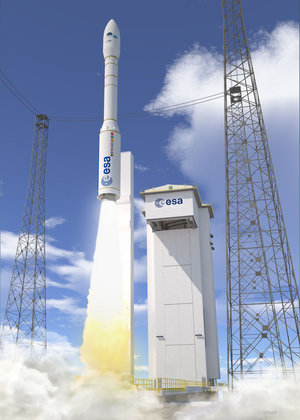Accept all cookies Accept only essential cookies See our Cookie Notice

About ESA
The European Space Agency (ESA) is Europe’s gateway to space. Its mission is to shape the development of Europe’s space capability and ensure that investment in space continues to deliver benefits to the citizens of Europe and the world.
Highlights
ESA - United space in Europe
This is ESA ESA facts Member States & Cooperating States Funding Director General Top management For Member State Delegations European vision European Space Policy ESA & EU Space Councils Responsibility & Sustainability Annual Report Calendar of meetings Corporate newsEstablishments & sites
ESA Headquarters ESA ESTEC ESA ESOC ESA ESRIN ESA EAC ESA ESAC Europe's Spaceport ESA ESEC ESA ECSAT Brussels Office Washington OfficeWorking with ESA
Business with ESA ESA Commercialisation Gateway Law at ESA Careers Cyber resilience at ESA IT at ESA Newsroom Partnerships Merchandising Licence Education Open Space Innovation Platform Integrity and Reporting Administrative Tribunal Health and SafetyMore about ESA
History ESA Historical Archives Exhibitions Publications Art & Culture ESA Merchandise Kids Diversity ESA Brand Centre ESA ChampionsLatest
Space in Member States
Find out more about space activities in our 23 Member States, and understand how ESA works together with their national agencies, institutions and organisations.
Science & Exploration
Exploring our Solar System and unlocking the secrets of the Universe
Go to topicAstronauts
Missions
Juice Euclid Webb Solar Orbiter BepiColombo Gaia ExoMars Cheops Exoplanet missions More missionsActivities
International Space Station Orion service module Gateway Concordia Caves & Pangaea BenefitsLatest
Space Safety
Protecting life and infrastructure on Earth and in orbit
Go to topicAsteroids
Asteroids and Planetary Defence Asteroid danger explained Flyeye telescope: asteroid detection Hera mission: asteroid deflection Near-Earth Object Coordination CentreSpace junk
About space debris Space debris by the numbers Space Environment Report In space refuelling, refurbishing and removingSafety from space
Clean Space ecodesign Zero Debris Technologies Space for Earth Supporting Sustainable DevelopmentLatest
Applications
Using space to benefit citizens and meet future challenges on Earth
Go to topicObserving the Earth
Observing the Earth Future EO Copernicus Meteorology Space for our climate Satellite missionsCommercialisation
ESA Commercialisation Gateway Open Space Innovation Platform Business Incubation ESA Space SolutionsLatest
Enabling & Support
Making space accessible and developing the technologies for the future
Go to topicBuilding missions
Space Engineering and Technology Test centre Laboratories Concurrent Design Facility Preparing for the future Shaping the Future Discovery and Preparation Advanced Concepts TeamSpace transportation
Space Transportation Ariane Vega Space Rider Future space transportation Boost! Europe's Spaceport Launches from Europe's Spaceport from 2012Latest
ESA 2012 Highlights
Thank you for liking
You have already liked this page, you can only like it once!
2012 was a very busy and fruitful year for ESA. This video looks back at this year in space with an overview of ESA missions and events.
In particular, 2012 will remain a historic year for European launchers, because it saw the successful qualification flight of ESA's Vega launcher and the birth of Ariane 6, which was agreed at the Ministerial Council in November. Three types of launcher lifted off from Europe’s Spaceport in French Guiana: Ariane 5, Soyuz and then the Vega, completing the full range of European launch services and capabilities.
ESA astronaut Andre Kuipers was the latest European to stay on the International Space Station. During his six-month stay from December 2011 to July 2012, he oversaw the docking of ESA's third supply spacecraft, ATV Edoardo Amaldi, to the Station.
The year was also important for Europe's Galileo global navigation satellite system, when the third and fourth satellites were launched from Europe’s Spaceport in French Guiana in October. They join the first pair of satellites launched a year ago to complete the validation phase of the Galileo programme.
In November, ministers from ESA’s 20 Member States and Canada met and allocated the budget for ESA’s space activities and programmes for the years to come. Along with the new Ariane 6 launcher, they secured investments for the development of Ariane 5 ME and also gave the green light for Europe to provide the service module of NASA’s new Orion Multipurpose Crew Vehicle.
This decision is strategically important for Europe as it will enable a cooperation between ESA and NASA on future human space transportation.
-
CREDIT
ESA -
LICENCE
ESA Standard Licence
-
Documentary
-
-
-
-
-
-
-
2012 Ministerial Council Antenna Astronauts Astronauts on board Astronauts on board ISS ATV ATV (Automated Transfer Vehicle) Clean room Climate Engineers In-Orbit Validation (IOV) Innovation Satellite constellation Satellite navigation Solar Telescope Transit Vega Vega Venus Weather Weather forecasts Weather maps Weather satellite

Vega, Soyuz and Ariane launch pads at Europe's Spaceport

Three launchers at Europe’s Spaceport

2012 ESA Missions Preview

Ariane 6















 Germany
Germany
 Austria
Austria
 Belgium
Belgium
 Denmark
Denmark
 Spain
Spain
 Estonia
Estonia
 Finland
Finland
 France
France
 Greece
Greece
 Hungary
Hungary
 Ireland
Ireland
 Italy
Italy
 Luxembourg
Luxembourg
 Norway
Norway
 The Netherlands
The Netherlands
 Poland
Poland
 Portugal
Portugal
 Czechia
Czechia
 Romania
Romania
 United Kingdom
United Kingdom
 Slovenia
Slovenia
 Sweden
Sweden
 Switzerland
Switzerland


























